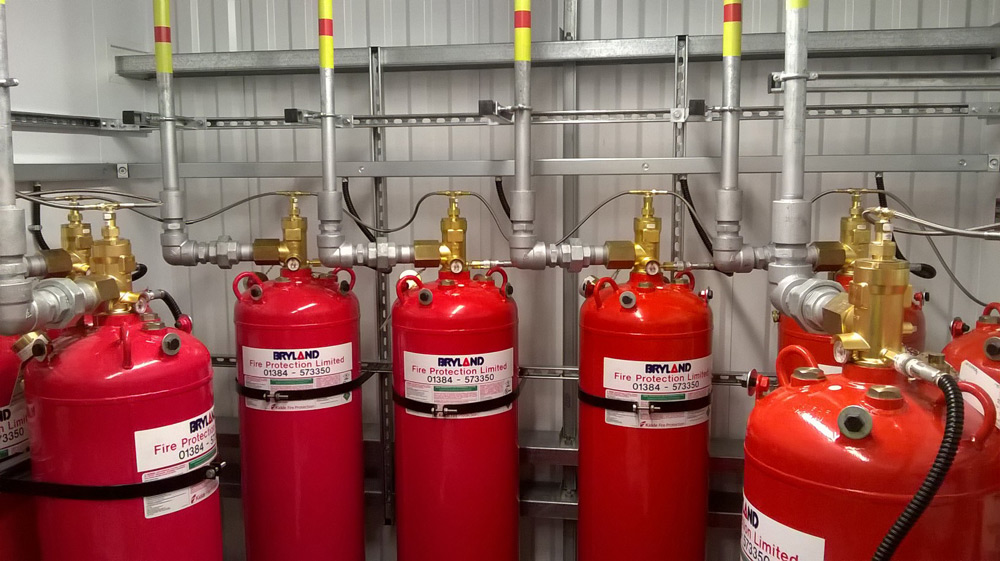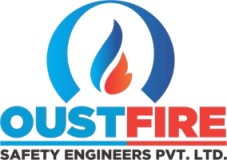A Gas Suppression system is a waterless fire suppressant that functions by releasing a gas, or mixture of gases, into the air with the aim of extinguishing and/or preventing the fire spread within a building.
To understand how fire suppression systems achieve this we should first review the principal aspects of fire chemistry. Four components; fuel, oxygen, heat, and the combustion chain reaction are often referred to as the “fire tetrahedron”.
All four of these factors are required in the correct combination for a fire to ignite and sustain burning. The fire tetrahedron shows that a fire can be extinguished by eliminating one or more of the links between these components or by changing the balance between them;
- By interrupting the combustion chain reaction
- By containing or eliminating the source of fuel
- By cutting off or diluting the source of oxygen
- By removing enough heat from the fire

The two common methods of gaseous fire suppression are:
- Oxygen Reduction: Inert gases such as argon and nitrogen extinguish fire mainly by the third mechanism in the tetrahedron, diluting the oxygen level below 15 volume percent, the level required to support combustion. When the oxygen levels in the air are reduced below that 15% threshold the fire no longer has enough fuel to continue and therefore MOST materials will cease to burn.
- Chemical means: Chemical extinguishes principally via the fourth mechanism by removing heat from the fire. Upon discharge, these systems create a gaseous mixture with air. This agent/air mixture has a heat capacity much larger than that of air alone. A higher heat capacity means that this gas mixture will absorb more energy (heat) for each degree of temperature change it experiences.
Gas Suppression Systems are sometimes manually activated; however, most are automatic. An automatic system functions through the conjunction of three key elements; a smoke detector, notification device and control panels.
The smoke detectors are the first line of defence and will alert the control panel if smoke is detected within the vicinity. The control panel will then inform the notification device and the piping to begin releasing the gas into the required location. Occupants of the area will be notified by the notification system and made aware that the fire suppressing agent will soon be released.
The Benefits of a Gas Suppression System
- Non-conductive: In comparison to traditional firefighting methods, Gas Suppression Systems do not conduct electricity and therefore create a safer means if extinguishing electrical fires.
- Quick Response: Not only will a gas suppression system quickly extinguish a fire, reducing the amount of damage caused by the ignition itself, but also can minimise the amount of damage caused by smoke and soot the occurs as a by-product of the fire.
- Minimal Damage: The damage caused by the fire is not the only concern when dealing with a business fire, the residue or water left behind by a traditional fire extinguisher can be extremely damaging to items like electronics. With a gas suppression system, your business will be back up and running much quicker, as there is much less clean up required in the aftermath of the fire’s extinction.
- Protect Employees and Occupants: Since a gas suppression system can be used in rooms that are both occupied and unoccupied (system dependant), there is no need for evacuation before the system is triggered and therefore the fire will be extinguished faster, protect your valuable human resources.
- Eco – Friendly: Clean agent gas suppression systems such as the Novec 1230, are environmentally friendly and will not contribute to the depletion of the earth’s ozone.
When Would You Need A Gas Suppression System?
Gas suppression is ideally suited in an area where other forms of firefighting may cause water damage to electrical goods.
For example, a server room where data is stored would benefit from a gas suppression system to protect as much of the data as is possible in the event of a fire.
Furthermore, electrical rooms occupied by employees cannot be fought with traditional firefighting methods as the combination of electricals and water would pose a risk to life.
Conducting a Fire Risk Assessment will reveal if a Gas Suppression System is necessary for your premises, always refer to the RRO 2005 when conducting an FRA.
Gas Suppression Regulation
All gas suppression systems should be tested in accordance with BS 5430-1:1990 where high-pressure cylinders are utilised.
The system should be designed in accordance to the standards BS EN 15004-1 which cover the design, installation and maintenance of the system and guidance on room integrity testing that ensures the areas protected by these systems are capable of retaining the gas on discharge for ten minutes (twenty if the agent involves carbon dioxide).
Pressure Relief Ventilation
Testing by BRE, FSSA and others has determined that all suppression systems create over pressurisation upon system discharge. Chemical gases (i.e. FM-200, NOVEC 1230 etc.) create under and over pressurisation upon system discharge. To protect against possible structural damage, it is recommended to install a pressure relief vent that discharges to fresh air.
Post Discharge Extraction
In protected enclosures means for prompt natural or forced-draft ventilation of areas after any system discharge should be provided, to safely remove fire by-products and extinguishant (as per EN 15004-1 and ISO 14520-1). Forced draft ventilation will often be necessary. Care should be taken to completely dissipate hazardous atmospheres and not just move them to other locations. It should be noted that most extinguishing agents are heavier than air.
